by Winding Pathways | Jan 11, 2018 | Geology/Weather
Today it’s easy to buy just about anything by touching a few keystrokes. In an amazingly short time, a package from Amazon or another company will arrive. However, it wasn’t always easy to acquire important things. Consider obsidian.
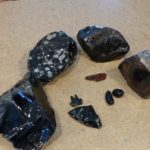
Snowflake, Conchoidal shape, Apache tears.
Obsidian is a fascinating rock always formed by volcanic action. It’s essentially natural glass, and a chunk of it shimmers in the hand. It’s usually black but can be brown, tan, green, blue, red, orange or yellow depending on the minerals within it.
Although obsidian is found in natural deposits scattered around the world, in the United States it occurs mostly in Arizona, California, Idaho, Nevada, and Oregon with smaller deposits in New Mexico, Washington, and Wyoming. An entire obsidian hillside is easy to see from the road in Yellowstone National Park just south of Mammoth.
In days long before Amazon shipped packages, obsidian was one of the most precious of commodities. Imagine you are Native American thousands of years ago. Some of this evening’s dinner may come from corn or squash you grew but more likely it would be deer, elk, rabbit or squirrel meat or even a big catfish fillet.
Back then hunting wasn’t recreation. It was a vital source of food, and hunters had to do whatever possible to make catching an animal successful. They spent hours crafting efficient spears long before the bow and arrow were invented. After bows replaced spears Native Americans crafted efficient arrows.
Obsidian was the very best rock to make spear and arrow points from. It fractures into flakes so sharp that it has been used for modern surgical scalpels. It makes beautiful and deadly spear and arrow points.
Most Native Americans had a problem. There was no natural obsidian within hundreds or thousands of miles of their homes. Often, they used flint or chert for points. These worked well, but Obsidian was better. It was a valuable commodity.
Long before history began recording events Native Americans had developed elaborate trade routes across North America. One of the most valuable trade items was obsidian. We live in Iowa, and there are no known natural obsidian deposits. But obsidian arrowheads are relatively common. There’s no doubt that it came here, and throughout most of North America, carried great distances by traders who walked around the continent and swapped it for items they needed.
Modern bowhunters use arrows tipped with razor-sharp steel points, but obsidian is still valued for its beauty and unusual shapes and colors. Today it’s zipped around the world in cars, planes, trucks, and ships. It’s even possible to order it from Amazon.
by Winding Pathways | May 16, 2016 | Geology/Weather, Nature, Trees/Shrubs
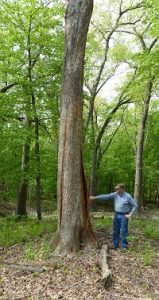
This stately Oak took a full bodies hit that vaporized the sap and blew off the bark in four places.
An enormous explosion brought us bolt upright in bed. 10:44 p.m. just after we’d fallen asleep on April 27th. . The blast was so powerful it knocked pictures off the wall shattering the frames and glass. A quick check revealed no other home damage and a few low rumbles assured us that the noise had been thunder created by a very close lighting strike and not a bomb.
A few days later we discovered a massive white oak about 300 feet from our home with its bark blown off in four different places and loose in others. The lightning’s heat and force vaporized the tree’s sap and enormous pressure blew the bark off. It’s hard to imagine that so much damage could happen in a two tenths of a second-long lightning bolt. The thing is, the tree top is lower than our home! Why did lightning strike there and not the house?
A lightning strike isn’t always a tree’s kiss of death. If only a narrow swath of bark is blown off it may recover. But we fear our magnificent oak was so damaged that its days are numbered.
The tree’s imminent death is good news for small songbirds, especially brown creepers that seek shelter between loose bark and a tree’s trunk. As the oak gradually deteriorates it will provide food and shelter for a host of insects and the woodpeckers that love dining on them. We anticipate a day when our pileated, red headed, red bellied, hairy and downy woodpeckers nest in the old oak snag. Eventually it will topple over and over time return nutrients from rotting wood to the soil.
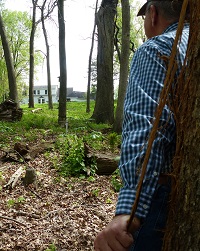
The distance from the lightning strike to the house is about a football field.
Lighting can be both lethal and sneaky. Every year it strikes about 25 million times in the United States and kills an average of 49 people. Many more humans are hit but survive, often with lingering physical problems. Ligntning is nothing to fool around with. As we learned on April 27th sometimes lightning strikes well before the main storm arrives and after it leaves. The safest place to be is inside a building away from windows, pipes, water, wires and landline telephones.
To stay safe, follow the 30-30 rule of thumb. When you first see lightning, begin to count “One Mississippi, two Mississippi….” until you hear thunder. If you hear thunder before you reach the number 30, lightning from the storm is in striking distance. Go inside! And, after the last rumble of thunder wait 30 minutes before venturing outside again.
An outstanding source of information, including many safety tips, is on the US Government’s website.
by Winding Pathways | Apr 10, 2016 | Geology/Weather, Nature
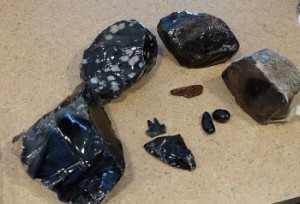
A volcanic glass, Obsidian occurs in volcanic areas such as the western United States.
We’re honored to welcome visitors to our Winding Pathways website seeking information on obsidian. Many have probably learned of this rock through video games.
Ironically Winding Pathways is located in Iowa, a state where natural deposits of obsidian aren’t found. However, the rock was so useful to Native Americans that an extensive trade network existed in North America and it was carried far and wide by prehistoric traders. All Iowa obsidian was carried here by Native Americans and has only been found as artifacts.
Obsidian is an amazing rock. It formed when lava cooled so quickly that the molten rock could not form a crystalline structure. Usually black, obsidian can be of many other colors. It occurs naturally around the world where volcanism occurred relatively recently. Fairly common in western states it has also been found in Pennsylvania, North Carolina and Virginia. A well-known hillside in Yellowstone National Park is composed of this rock. It’s fun to see but collecting is not allowed in national parks.
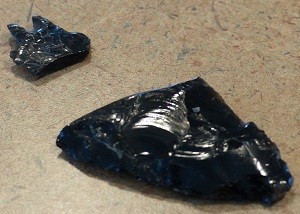
The smaller piece is the back of a point. The larger piece is the broken tip of a point.
Because of its amorphous, or non-crystalline, structure obsidian breaks cleanly creating extremely sharp edges. It’s been used by people for at least 1.5 million years as the raw material that could be crafted into knives, spear points and other sharp tools. Today obsidian is often made into jewelry, and there are reports of ultra-sharp shards of it being used for surgery.
An easy way to see obsidian and hundreds of other types of rocks and minerals is to visit a rock shop. They are common in tourist areas, and we’ve always found visiting them fun. Often the owner is so happy to see a customer that he’ll give a personal tour and share oodles of rock information, even if no money is exchanged.
Another great way to see obsidian……and buy a chunk……..is to visit a rock show. Held around the country they bring rock enthusiasts together to talk, barter, buy and sell. To locate a show near your home check RockNGem and show-dates.
Eastern Iowa’s 2016 Cedar Valley Rock and Mineral Society’s big Gem, Mineral and Fossil Show will be April 16 and 17 at Hawkeye Downs in Cedar Rapids. Programs, demonstrations, pebble pits for kids, gorgeous jewelry, equipment and raw materials all will be featured.
Wherever you live, take in a rock show and rub elbows with rock hounds and lapidists, and invest in some cool rocks and crystals.
by Winding Pathways | Feb 28, 2016 | (Sub)Urban Homesteading, Chickens, Energy Efficiency, Geology/Weather, Nature
How ironic that many homeowners don’t harvest the rain that falls on their property, yet they buy water to irrigate their lawn and garden. Harvest free water by using rain barrels and rain gardens.
RAIN BARRELS
Since ancient times families have captured rain falling on their roof to use for irrigation. It worked thousands of years ago and still works today. A rain barrel is a large container positioned under a gutter downspout to catch and hold water for later use. They can be homemade but most people prefer buying one. Hundreds of models are on the market and range from simple and inexpensive ones to elaborately designed barrels that are practical and decorative. We purchased ours from Rainwater Solutions and have placed six under the downspouts of two buildings. The free water irrigates our vegetable garden and provides water for our small flock of chickens. For more information see the Winding Pathways blog of April 2015 or check http://www.rainwatersolutions.com/
RAIN GARDENS
Rain gardens are more permanent than barrels. Like the barrels they range from the simple to the elaborate. Rain gardens aren’t used to harvest water for irrigation but channel roof runoff into the ground rather than into storm sewers.
Our rain garden is simple and cost nothing to create. We dug a shallow basin in the lawn about the size of a bath tub where our downspout discharges gutter water. During a light to moderate rain our rain garden absorbs all the roof water and puts it back into the ground where it moistens roots and eventually helps recharge the aquafer. During a fierce thunderstorm it overflows a little but we channel that to the lawn. Between the garden and lawn all the rain falling on our roof stays on our property, benefiting our plants and not creating flooding downhill.
The Indian Creek Nature Center and Linn County Master Gardeners will hold workshops in March 2016 to help participants learn how to make their own rain garden. Other nature centers, master gardener and Extension Offices hold similar workshops in many locations across the country. Books and websites are available to help homeowners plan their rain garden. One of our favorite information sources is the Low Impact Development Center.
Besides harvesting water and reducing downstream flooding there’s another benefit of having a rain garden. Flowering plants that require wet soil flourish in rain gardens but can’t live in nearby dry soil.
by Winding Pathways | Feb 5, 2016 | Children/Play, Geology/Weather, Nature, Wonderment
Kids enthusiasm about playing in the snow is evident with snowmen around town, tracks across yards, piles of wet boots and mittens and gay laughter ringing through the town. Two children share their reasons they love to “Go Outside and Play!”
-

-
Musher Devany Souza on her magical “first snow” trip to Alaska
-
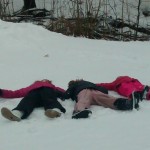
-
Part of the fun of snow is making snow angels.
-

-
An intrepid sledder walks back up the hill.
-

-
Smiles in the snow!
-

-
Drying out the clothes
-Savannah. “I like to play outside when it’s snowing because we can do several different things. We can throw snowballs at each other. We can make big snow forts and hide in them. We also slide down our icy slide so we can go extra fast. So all together, we play in the snow whenever we get the chance.”
-Breanna. “When it’s snowing I like to go outside. The reason I like to go outside is because I like to go
sledding really fast down a hill. I also like to build
snowmen while my brother and sister go find accessories. I like to find cool
foot prints in the snow. And I think it is fun to throw snowballs at my brother and sisters. And that is why I like to go outside.”
by Winding Pathways | Jan 18, 2016 | Geology/Weather, Nature, Preparedness

Dress in Layers, wear sturdy, insulted boots, and soak up Vitamin D with a brief “sun bath” even on cold winter days.
The woman giving our local television station’s weather report issued a dire warning. “It’s going to be below zero tomorrow with strong wind. It will feel like 30 below zero out. Stay inside”, she advised!
A gorgeous sunrise launched the next morning. It was a cold six below zero out but with only slight wind. Birds and squirrels arrived at the feeder, snatched a few seeds and flew or scampered off to enjoy breakfast in a sunny spot sheltered from the breeze.
Rarely do we have weather so bad that everyone must stay indoors. Certainly some days are more pleasant than others but at Winding Pathways we go outside, even if briefly, whether it’s frigid or broiling out -mainly to tend our animals. We mimic wildlife.
When August’s heat and humidity envelop Iowa we follow the pattern of the cottontail that lives in our yard. He and we are out in the evening and early morning. In mid-day we shun the sun and enjoy our maple’s cool shade. On blustery winter days we layer up and explore our yard, even if for just a short time. Modern clothing is amazingly effective keeping us comfortable as long as we do like our chickadees and find a sunny place out of the wind. We don’t fool around with tornadoes. If one’s approaching we heed the weather caster’s advice and stay in the basement. But, as soon as it passes we’re out in the yard.
Take temperature extremes seriously. Unusually hot or cold weather can cause serious physical problems, even death, but a prudent person who takes precautions and uses common sense will enjoy fresh air even in extreme weather.
BE CAREFUL, DRESS APPROPRIATELY, AND AVOID BEING UNDULY “SCARED” BY THE WEATHER REPORT.
“Climb the mountains and get their good tidings. Nature’s peace will flow into you as sunshine flows into trees. The winds will blow their own freshness into you, and the storms their energy, while cares will drop off like autumn leaves,” John Muir.











